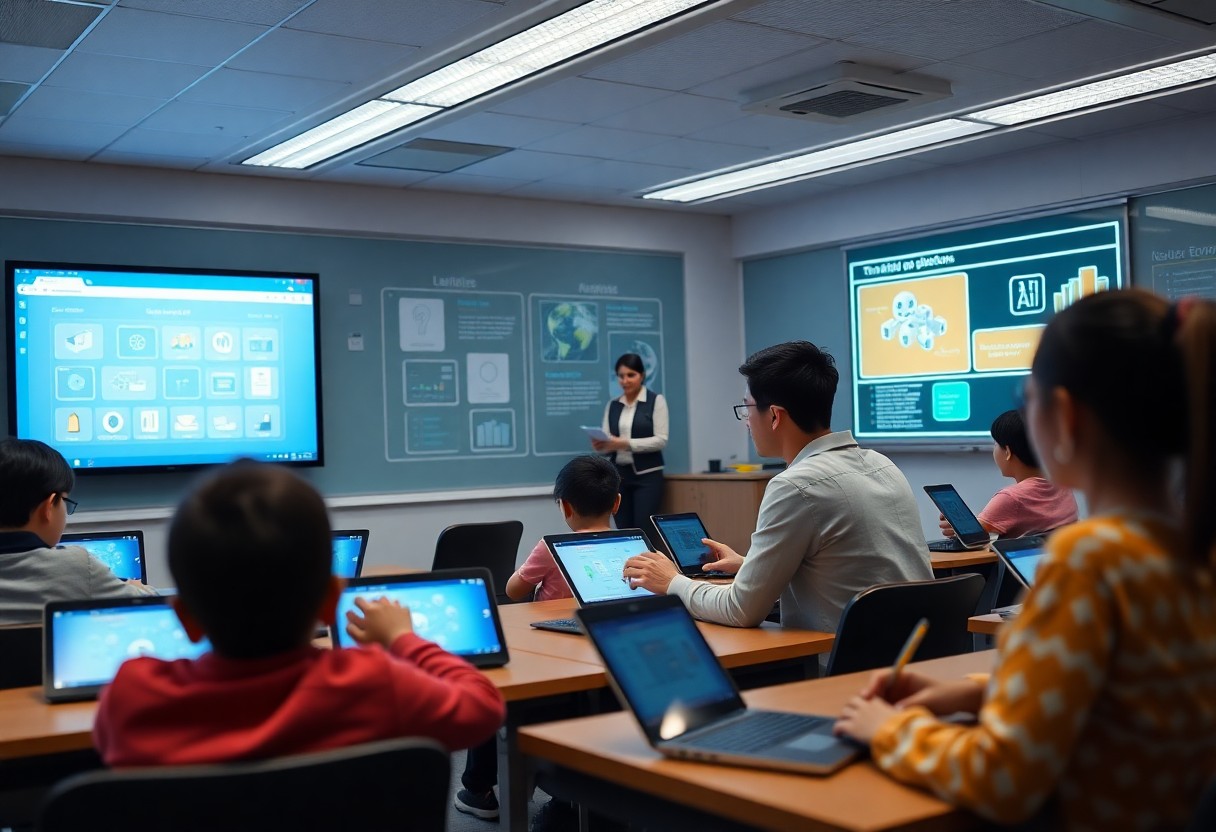Just as technology continues to revolutionize various aspects of our lives, AI-driven education systems are poised to transform the way we learn. This article probes into the potential of utilizing AI in education, exploring the benefits and challenges of this innovative approach. Join us as we unravel the impact of AI on the future of learning.
The Current State of Education
While traditional teaching methods have long been the foundation of the education system, they come with their limitations. For instance, the one-size-fits-all approach does not cater to the diverse learning styles and paces of individual students. Additionally, the lack of personalized attention in crowded classrooms can hinder the academic progress of students who may require extra support.
Limitations of Traditional Teaching Methods
For many students, traditional teaching methods may not effectively engage or support their learning needs. This can lead to disinterest, disengagement, and ultimately a lack of academic success. Addressing these limitations is crucial to ensuring that all students have the opportunity to thrive in an educational setting.
The Rise of Digital Learning Platforms
An increasing number of educational institutions are turning to digital learning platforms to enhance the learning experience. These platforms offer interactive lessons, personalized learning paths, and real-time feedback. Education has the potential to become more accessible and tailored to individual student needs with the integration of digital tools.
The Emergence of AI-Driven Education Systems
Definition and Key Features
Assuming the role of a game-changer in the field of education, AI-driven education systems are revolutionizing the way students learn and teachers teach. These systems harness the power of artificial intelligence to personalize educational experiences, streamline administrative tasks, and provide real-time feedback to enhance learning outcomes.
- Personalization: Tailoring educational content and pace to individual student needs.
- Automation: Assisting with administrative tasks such as grading, scheduling, and record-keeping.
- Adaptability: Modifying teaching methods based on student performance and engagement levels.
Any educational institution looking to enhance student learning experiences and optimize teaching efficiency can benefit from implementing AI-driven education systems.
Early Adopters and Success Stories
Definition
It’s fascinating to see how early adopters of AI-driven education systems are reaping the benefits of this cutting-edge technology. From improving student engagement and retention rates to assisting teachers in identifying areas for curriculum improvement, the success stories are multiplying across various educational settings.
Personalized Learning Experiences
Some of the most exciting advancements in education are happening through personalized learning experiences driven by artificial intelligence. These systems have the potential to revolutionize the way students learn by tailoring educational content to their individual needs and preferences.
Adaptive Assessments and Real-time Feedback
To enhance personalized learning experiences, AI-driven systems can provide adaptive assessments that measure a student’s knowledge and understanding in real-time. Through continuous evaluation, these systems can offer personalized feedback and suggestions to help students improve their performance. This immediate and personalized guidance can be invaluable in helping students grasp topics effectively and overcome learning obstacles.
Customized Learning Paths and Recommendations
Customized learning paths and recommendations based on AI algorithms can optimize the learning journey for each student. By analyzing data on a student’s learning patterns, preferences, and strengths, these systems can provide tailored recommendations on study materials, resources, and even potential career paths. This individualized approach not only keeps students engaged but also helps them achieve better learning outcomes.
Learning in a setting where every student receives personalized attention and guidance can lead to improved academic performance and foster a lifelong love for learning. With AI-driven education systems offering such personalized experiences, the future of learning indeed looks promising and exciting.
Intelligent Tutoring Systems
For many students, one of the most significant challenges in education is personalized support and individualized attention. Intelligent Tutoring Systems (ITS) offer a promising solution by providing tailored learning experiences based on the student’s pace, preferences, and learning style. These systems use AI algorithms to analyze student performance data, identify areas of improvement, and deliver customized learning modules to address specific needs.
Human-AI Collaboration in Education
An necessary aspect of Intelligent Tutoring Systems is the collaboration between humans and AI. Educators can utilize data insights generated by ITS to make informed decisions about their teaching strategies and provide timely interventions when necessary. By working in tandem with AI, teachers can better understand student progress and offer targeted support, ultimately enhancing the overall learning experience.
AI-Powered Virtual Learning Environments
The integration of AI in virtual learning environments has revolutionized the way students engage with educational content. AI-powered systems can adapt to individual learning styles, offer real-time feedback, and create interactive simulations that enhance understanding. These technologies have the potential to make learning more engaging, effective, and accessible to a wider range of learners.
Plus, AI-powered virtual learning environments can analyze vast amounts of data to personalize the learning experience further. By tracking student interactions and performance, these systems can adjust course materials, suggest additional resources, and provide targeted support to help students succeed.
Natural Language Processing in Education
AI-Driven Language Learning Tools
Language is a fundamental aspect of education, and AI-driven language learning tools are revolutionizing the way students engage with and master new languages. These tools use Natural Language Processing (NLP) to provide personalized learning experiences, adapt to individual student needs, and offer real-time feedback on pronunciation, grammar, and vocabulary. By leveraging NLP, these tools can accurately assess a student’s proficiency levels and tailor lessons to address their weaknesses, ultimately enhancing language learning outcomes.
Automated Essay Scoring and Feedback
To further streamline the learning process, automated essay scoring and feedback tools powered by NLP are gaining popularity in educational settings. These tools can analyze essays for structure, coherence, and grammar, providing students with instant, detailed feedback on their writing skills. Additionally, automated essay scoring can save teachers valuable time by automating the grading process, allowing them to focus on providing more personalized support to students.
This development in AI-driven education systems marks a significant shift in the way students learn and educators teach. While the use of NLP in education has its advantages in enhancing learning outcomes and streamlining administrative tasks, there are concerns about the potential lack of nuance and human interaction in the learning process. It is imperative to strike a balance between leveraging AI for efficiency and maintaining the human touch in education to ensure a well-rounded learning experience for students.
AI-Assisted Content Creation
Not only can AI help students learn more efficiently, but it can also assist educators in creating high-quality educational content.
Intelligent Authoring Tools for Educators
Educators can benefit from AI-powered tools that help them create engaging and personalized learning materials. These tools can analyze the learning needs of individual students, suggest relevant content, and even automate the process of creating lesson plans and assessments. By utilizing these intelligent authoring tools, educators can save time and effort while delivering more effective and tailored instruction.
AI-Generated Educational Resources
Content
For instance, AI can generate quiz questions, worksheets, and interactive simulations based on the specific learning objectives of a lesson. This not only saves educators time on manual content creation but also ensures that the resources are aligned with the curriculum and optimized for student engagement. AI-generated educational resources can provide valuable support to educators, allowing them to focus on facilitating learning experiences and fostering critical thinking skills in students.

Enhanced Accessibility and Inclusion
AI-Powered Assistive Technologies
With the integration of AI-driven assistive technologies in education systems, students with disabilities are finding a more inclusive learning environment. These technologies can personalize learning experiences by adapting to the unique needs of each student, offering real-time feedback, and providing additional support where necessary.
Expanding Access to Education for All
Access to education is a fundamental right, yet many barriers exist for individuals worldwide. AI-driven education systems have the potential to break down these barriers by providing flexible learning opportunities that cater to diverse learning styles and abilities.
AI-powered education systems have the capacity to reach remote areas where traditional forms of education might not be readily available. By leveraging technologies like online platforms, virtual classrooms, and personalized learning modules, individuals who were once left out of the education system can now access quality education.
Addressing Concerns and Challenges
Job Displacement and the Future of Teaching
Concerns: Keep in mind that the integration of AI-driven education systems may lead to concerns about job displacement in the education sector. As AI technology advances, there may be fears about the future of teaching roles as AI systems take on more instructional tasks. However, it is crucial to remember that while AI can assist in certain aspects of teaching, the role of teachers as mentors and guides remains irreplaceable.
Ensuring AI Transparency and Accountability
Challenges: Keep in mind that as AI-driven education systems become more prevalent, ensuring transparency and accountability in their decision-making processes is crucial. Without clear guidelines and regulations, there is a risk of biases or errors creeping into the algorithms that power these systems, potentially leading to unfair treatment of students. For instance, it is important to have mechanisms in place to regularly review and audit AI algorithms to guarantee fairness and accuracy in educational outcomes.
The Role of Human Teachers in AI-Driven Education
Evolving Teacher Roles and Responsibilities
To evolve in the era of AI-driven education, human teachers must adapt and redefine their roles. While AI can facilitate personalized learning experiences and provide instant feedback, it cannot fully replace the human element in education. Teachers will need to focus on guiding students in navigating the vast amount of information available, fostering critical thinking, creativity, and emotional intelligence.
Fostering Human-AI Collaboration in the Classroom
Fostering collaboration between human teachers and AI systems is crucial for the success of AI-driven education. Teachers should view AI as a tool to enhance their teaching methodologies rather than a threat to their profession. By leveraging AI to automate administrative tasks, provide data-driven insights, and create personalized learning plans, teachers can allocate more time to mentorship, emotional support, and cultivating a growth mindset.
HumanAI Collaboration in Practice
HumanAIs collaboration can lead to more effective and efficient teaching methods tailored to individual student needs. Teachers can use AI-powered analytics to identify areas where students may be struggling and intervene promptly. Additionally, AI can assist in creating adaptive learning paths that cater to different learning styles, further enhancing the educational experience for students.
Implementing AI-Driven Education Systems
Many considerations need to be taken into account when implementing AI-driven education systems. From infrastructure and technical requirements to change management and professional development, the successful integration of artificial intelligence into educational settings requires careful planning and execution.
Infrastructure and Technical Requirements
Implementing AI-driven education systems necessitates a robust infrastructure capable of handling the complex algorithms and data processing requirements. Schools and institutions must invest in high-speed internet, secure networks, and compatible devices to ensure seamless integration. Additionally, technical support and training for staff are crucial to navigate the intricacies of AI technologies.
Change Management and Professional Development
Management of change is crucial in the implementation of AI-driven systems in education. It involves not only introducing new technologies but also reshaping pedagogical approaches and shifting mindset towards a more data-driven instructional model. Professional development programs that focus on upskilling educators to effectively leverage AI tools and interpret data insights are imperative for successful adoption.
Another critical aspect of change management and professional development is fostering a culture of innovation and continuous learning within educational institutions. Encouraging collaboration, experimentation, and adaptation to new technologies will nurture a dynamic environment where AI can truly enhance the learning experience for students.
Implementing AI-driven education systems requires a strategic approach to infrastructural enhancements and training, as well as a comprehensive change management strategy.
Measuring Success and Evaluating Impact
Many educators and administrators are curious about how to measure the success and impact of AI-driven education systems.
Key Performance Indicators (KPIs) and Metrics
An crucial aspect of evaluating these systems is identifying the key performance indicators (KPIs) and metrics that will provide insights into their effectiveness. These KPIs could include student engagement levels, learning outcomes, retention rates, and overall satisfaction with the learning experience. By tracking these metrics, educational institutions can make data-driven decisions to enhance the efficacy of AI-driven systems.
Longitudinal Studies and Research Opportunities
Longitudinal studies that track the progress of students over an extended period can provide valuable insights into the long-term impact of AI-driven education systems. By following students from their initial interactions with the AI system through to their graduation and beyond, researchers can determine the system’s effectiveness in improving learning outcomes and preparing students for their careers.
Plus, longitudinal studies can help identify any potential pitfalls or areas for improvement in AI-driven education systems. By analyzing data collected over time, researchers can pinpoint trends and patterns that may not be immediately evident in shorter-term studies.
Global Perspectives and Initiatives
International Adoption and Best Practices
All around the globe, educational institutions are rapidly adopting AI-driven systems to enhance learning outcomes. Many countries are investing heavily in AI technologies to revolutionize their education systems, leading to improved personalization and adaptability for students of all levels. Nations like the United States, China, and India have been at the forefront of integrating AI in education, showcasing best practices for the rest of the world to follow. From personalized lesson plans to intelligent tutoring systems, AI is reshaping how students learn and educators teach.
Collaborative Efforts and Knowledge Sharing
On a global scale, collaborative efforts and knowledge sharing are crucial in advancing AI-driven education systems. By sharing successful strategies and research findings, educators and policymakers can collectively work towards maximizing the benefits of AI in learning. International partnerships and initiatives like the UNESCO AI in Education Global Framework aim to foster collaboration and exchange of ideas among countries. Such initiatives are crucial in ensuring equitable access to AI-driven educational opportunities for all students worldwide.
Global forums and conferences serve as platforms for educators and AI experts to exchange knowledge and collectively tackle the challenges of integrating AI into education systems.
The Future of AI-Driven Education Systems
Despite some skepticism surrounding AI-driven education systems, many experts believe that they are the future of learning. These systems have the potential to revolutionize education by personalizing learning experiences and providing valuable insights for both educators and students. As technology continues to advance, the possibilities for AI in education are endless.
Emerging Trends and Advancements
Systems powered by artificial intelligence are constantly evolving, incorporating emerging trends such as machine learning algorithms, natural language processing, and predictive analytics. These advancements enable AI-driven education systems to analyze vast amounts of data, identify patterns in student behavior, and adapt learning materials in real-time to cater to individual needs. By harnessing the power of AI, educators can enhance the quality of education and improve student outcomes.
Potential Breakthroughs and Innovations
On the horizon are potential breakthroughs and innovations that could further revolutionize AI-driven education systems. Imagine a future where AI tutors can provide personalized feedback, virtual reality simulations can offer immersive learning experiences, and predictive analytics can anticipate student needs before they arise. These AIDriven innovations have the potential to create a more engaging, efficient, and effective learning environment for students of all ages.
1. Personalized learning adapts to every student’s needs and pace.
2. AI can provide instant feedback and tailored study recommendations.
3. Enhances engagement through interactive and immersive learning experiences.
4. Data-driven insights help educators make informed decisions about teaching.
5. Offers accessibility to high-quality education worldwide.
6. Continuous improvement and updates based on user interactions and feedback.
Final Words
Following this exploration of AI-driven education systems, it is evident that the future of learning holds immense potential for integration with artificial intelligence. As technology continues to advance, the possibilities for personalized, efficient, and engaging educational experiences seem limitless. While AI-driven systems may not replace traditional teaching entirely, they undoubtedly have the capacity to revolutionize the way we approach education.
FAQ
Q: What are AI-driven education systems?
A: AI-driven education systems are platforms that utilize artificial intelligence technologies to enhance and personalize the learning experience for students.
Q: How do AI-driven education systems work?
A: AI-driven education systems use algorithms to analyze data on students’ learning patterns and behaviors, offering personalized recommendations and feedback to optimize learning outcomes.
Q: What are the benefits of AI-driven education systems?
A: AI-driven education systems can adapt to individual learning styles, provide instant feedback, offer personalized learning paths, and enhance overall engagement and motivation among students.
Q: Are AI-driven education systems the future of learning?
A: While AI-driven education systems show great potential in revolutionizing the learning process, their full integration and impact on education systems are still evolving and require further research and development.
Q: How can AI-driven education systems improve learning outcomes?
A: AI-driven education systems can identify areas where students struggle and provide targeted support, offer adaptive learning experiences, and facilitate collaboration and active participation in the learning process.
Q: What are some challenges to implementing AI-driven education systems?
A: Challenges include data privacy concerns, the need for teacher training and support, ensuring equitable access to technology, and addressing potential biases in AI algorithms.
Q: How can educators leverage AI-driven education systems effectively?
A: Educators can benefit from AI-driven systems by using data insights to personalize instruction, incorporating technology to enhance teaching practices, and fostering a supportive and collaborative learning environment that complements AI technology.




